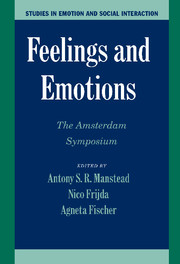Book contents
- Frontmatter
- Contents
- List of Contributors
- 1 Introduction
- PART I THE NATURE OF FEELINGS AND EMOTIONS
- 2 On the Passivity of the Passions
- 3 Emotions and Rationality
- 4 Emotions and Feelings
- 5 The Concept of an Evolved Fear Module and Cognitive Theories of Anxiety
- 6 Deconstructing the Emotions for the Sake of Comparative Research
- 7 From the Emotions of Conversation to the Passions of Fiction
- PART II BASIC PSYCHOLOGICAL PROCESSES IN FEELINGS AND EMOTIONS
- PART III FEELINGS AND EMOTIONS: THE PLACE OF PLEASURE
- PART IV FEELINGS AND EMOTIONS IN THEIR SOCIOCULTURAL CONTEXT
- PART V FEELINGS, EMOTIONS, AND MORALITY
- Subject Index
- Author Index
- Plate section
- References
2 - On the Passivity of the Passions
Published online by Cambridge University Press: 05 June 2012
- Frontmatter
- Contents
- List of Contributors
- 1 Introduction
- PART I THE NATURE OF FEELINGS AND EMOTIONS
- 2 On the Passivity of the Passions
- 3 Emotions and Rationality
- 4 Emotions and Feelings
- 5 The Concept of an Evolved Fear Module and Cognitive Theories of Anxiety
- 6 Deconstructing the Emotions for the Sake of Comparative Research
- 7 From the Emotions of Conversation to the Passions of Fiction
- PART II BASIC PSYCHOLOGICAL PROCESSES IN FEELINGS AND EMOTIONS
- PART III FEELINGS AND EMOTIONS: THE PLACE OF PLEASURE
- PART IV FEELINGS AND EMOTIONS IN THEIR SOCIOCULTURAL CONTEXT
- PART V FEELINGS, EMOTIONS, AND MORALITY
- Subject Index
- Author Index
- Plate section
- References
Summary
ABSTRACT
How much control do we have over our emotions? Does it make any sense to say that we choose our emotions? Psychologists talk about “emotion regulation,” leaving it open to what extent and in what ways the languages of control or of choice might apply. Philosophers have long taken the position, in part because of their celebration of reason, that we can control (but not choose) our emotions only by constraining them, or by controlling their expression. But are questions of regulation, control, and constraint perhaps misleading? In this chapter, I suggest that the active and even willful dimension of emotion has been too often dismissed, ignored, or what is the same, caricatured so that it makes no sense at all. I defend a model in which such voluntaristic talk captures some important insights about our emotions and consider several objections to this thesis.
The existentialist does not believe in the power of passion. He will never regard a grand passion as a destructive torrent upon which a man is swept into uncertain actions as by fate, and which, therefore is an excuse for them.
Sartre, “Existentialism Is a Humanism,” p. 33How much control do we have over our emotions? Does it make any sense to say that we choose our emotions? Psychologists talk about “emotion regulation,” leaving it open to what extent and in what ways the languages of control or of choice might apply.
- Type
- Chapter
- Information
- Feelings and EmotionsThe Amsterdam Symposium, pp. 11 - 29Publisher: Cambridge University PressPrint publication year: 2004
References
- 6
- Cited by



